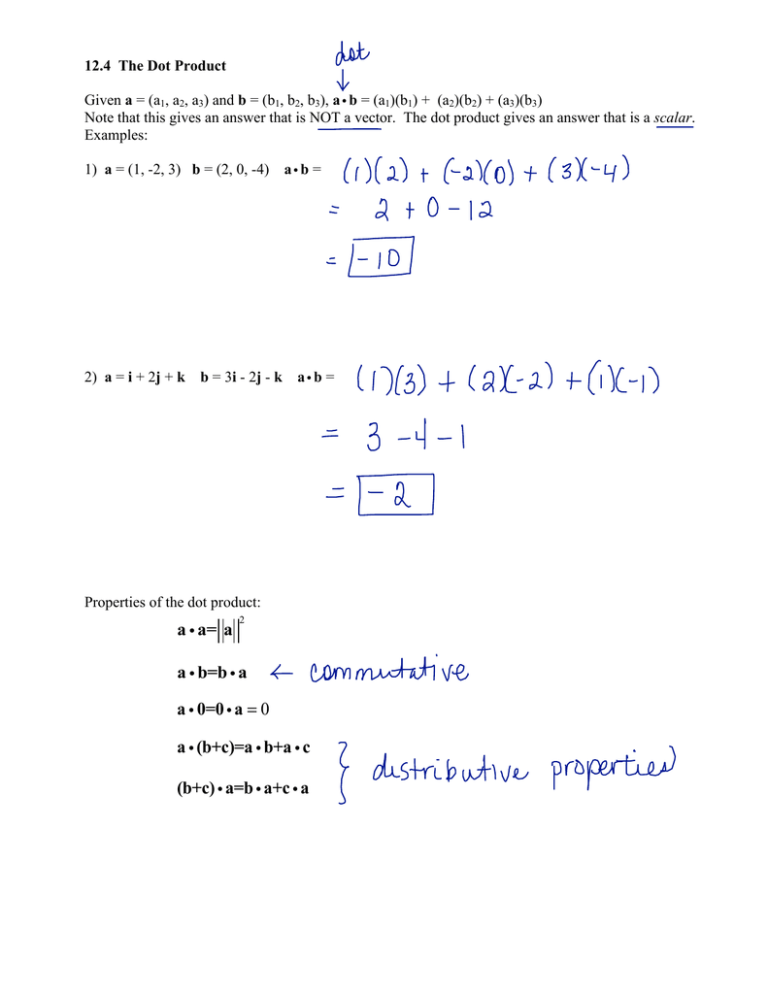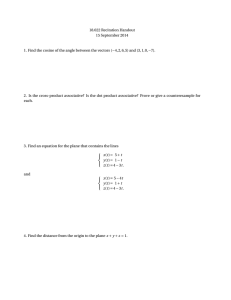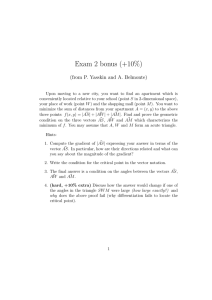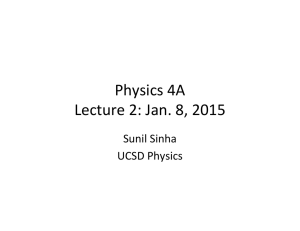a ia= a a ib=bia ai0=0ia = 0 ai(b+c)=aib+aic (b+c)ia=bia+cia
advertisement

12.4 The Dot Product Given a = (a1, a2, a3) and b = (b1, b2, b3), a i b = (a1)(b1) + (a2)(b2) + (a3)(b3) Note that this gives an answer that is NOT a vector. The dot product gives an answer that is a scalar. Examples: 1) a = (1, -2, 3) b = (2, 0, -4) 2) a = i + 2j + k b = 3i - 2j - k ai b = ai b = Properties of the dot product: a i a= a 2 a i b=b i a a i 0=0 i a = 0 a i (b+c)=a i b+a i c (b+c) i a=b i a+c i a Law of cosines: a c 2 = a 2 + b2 − 2ab cos θ c θ b Using vectors: This leaves us with So we can say: a i b= a b cosθ aib =cosθ a b Example: Find the angle between a = i +2j + k and b = 3i – 2j – k. ( ) Projection of a on b a|| : projba = λub where λ is the component of a in the direction of b and compba = a i ub Notice that a = a|| + a ⊥ and that a|| || b and a ⊥ ⊥ b Example: Find the projection of a on b: a = j + 3k b = 2i – j + 2k The angles α , β , γ that a vector makes with unit vectors i, j, and k are called direction angles of a. Examples: 1) Find a unit vector with direction angles: 2) Find the direction angles of a = i - 3k π 2π π 6 , 3 , 2 12.5 Cross Product If vectors a and b are NOT parallel, they form two sides of a parallelogram: a b a × b is the vector perpendicular to this plane. So, how do we find a × b? First we need to understand determinants: a1 a 2 = a1 b2 − a 2 b1 b1 b2 −1 3 = 4 2 Example: And for a 3x3: a d b e c f g h i = a b c Show that the answer above is the same as d e f = g h i e f h i a− d f g i b+ d e g h c Formula for Cross Product: for a = ( a1 , a2 , a3 ) and b = (b1 , b2 , b3 ) , a × b = Example: Calculate (3i -2j + k) × (j – 2k) The area of this parallelogram = || a × b || = ||a|| ||b|| sin θ where θ is the angle formed by a and b. Also, a, b, and a × b form a right hand triple: (read page 733 in text – properties of right handed triples) Now, if a || b then a × b = 0 Properties of Cross Product: Anticommutative: Scalar Factorization: Distributive Laws: Some identities: a × (b × c) = (a i c)b - (a i b)c (a × b) × c = (c i a)b - (c i b)a (a × b) i (c × d) = (a i c)(b i d) − (a i d)(b i c) Scalar triple product: (a × b) i c a, b, c is a right handed triple IFF (a × b) i c > 0 Parallelepiped: Volume = Example: Find a vector N that is perpendicular to the plane determined by points P, Q and R and find the area of triangle PQR. P(0,1,0) Q(1,-1,2) R(2,1,1) Example: Find the volume of the parallelepiped with edges: i – 2j +k , j + k, 2i – j - k




